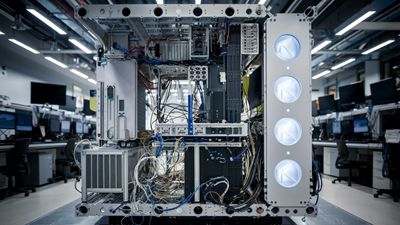Adobe’s Future Shaped by Generative AI: The Lasting Impact of Tools Like Firefly
Generative AI, exemplified by Adobe’s Firefly, is revolutionizing the content creation industry by enhancing productivity, fostering creativity, and creating new revenue opportunities. This report explores how generative AI impacts Adobe’s industry and evaluates its lasting positive impact on Adobe’s long-term value.
Introduction
Impact of Generative AI on the Content Creation Industry
Enhancing Productivity and Creativity
Generative AI is transforming the content creation process by automating labor-intensive tasks such as ideation, sketching, and iterations. According to Forbes, tools like Adobe Firefly allow creators to generate multiple image options almost instantly using text prompts, significantly speeding up the creative process. This automation enables creators to focus on more creative aspects of their work, thereby improving productivity and morale.
In the advertising sector, the ability to quickly produce customized content is a game changer. Creators can now experiment more freely and produce higher volumes of content, meeting the ever-growing demand for digital media. The generative AI content creation market, estimated at $11 billion in 2023, is projected to grow to $175 billion by 2033, reflecting a compound annual growth rate (CAGR) of 31%.
New Revenue Opportunities
Generative AI also opens up new revenue streams for content creators. As the scrutiny around data usage for training models increases, creators can earn more by allowing their images to be used for AI training and derivative content. This shift not only benefits individual creators but also enhances the overall ecosystem by ensuring that AI models are trained on high-quality, ethically sourced data.
Addressing Job Displacement Concerns
Despite fears of job displacement, the consensus among content creators is that generative AI will not replace them but will instead raise the baseline for all creators. The productivity gains from AI are expected to be utilized for increased content creation rather than downsizing. This perspective is crucial for understanding the broader impact of generative AI on the job market within the content creation industry.
Risks and Challenges
Legal and Ethical Concerns
The integration of generative AI into Adobe’s offerings is not without risks. One significant concern is copyright infringement. The U.S. Copyright Office has ruled that AI-generated artwork is not protected by copyright, raising liability issues for companies using such content. Adobe mitigates this risk by training its models exclusively with Adobe Stock images and freely licensed works, offering indemnity against intellectual property infringements.
Reputational Risks
Reputational damage is another potential risk. If AI-generated content is found to infringe on copyrights or if the quality of AI outputs does not meet user expectations, Adobe could face backlash. Therefore, maintaining high ethical standards and transparency is crucial. Adobe’s commitment to providing Content Credentials for AI-generated assets ensures that users are informed about how content was created, thereby fostering trust and accountability.
Loss of Know-How
The automation of creative tasks could lead to a loss of skills and knowledge among employees. As generative AI takes over more routine tasks, there is a risk that creators may become overly reliant on AI, potentially diminishing their creative skills over time. Adobe must balance the use of AI with initiatives that encourage continuous learning and skill development among its users.
Adobe’s Strategic Integration of Generative AI
Tailored Models and Rapid Scaling
Adobe’s approach to generative AI involves training its own models using licensed content and public domain resources, ensuring high-quality outputs aligned with creative use cases. By leveraging AWS, Adobe achieved a 20x increase in model training capacity within six months, showcasing its commitment to rapid innovation and scalability.
Deep Integration and Human-Centric Approach
The Firefly generative AI models are deeply integrated into popular tools like Photoshop and Illustrator. Features such as Generative Fill have become the most used in Photoshop, highlighting the practical benefits of AI integration. Adobe employs Reinforcement Learning with Human Feedback (RLHF) to continuously refine AI outputs, bridging the gap between machine learning and human creativity.
Ethical Standards and Transparency
Adobe’s commitment to ethical AI development is evident in its transparency and accountability measures. By providing Content Credentials for AI-generated assets, Adobe ensures that users are informed about the origins and creation process of the content they use. This approach not only builds trust but also sets a standard for ethical AI practices in the industry.
Long-Term Value and Financial Growth
Financial Projections
Adobe’s early adoption of generative AI positions the company for robust financial growth. The AI boom is expected to provide a significant boost in revenue, contributing to a CAGR of 15.5% needed to reach a $1 trillion market cap by 2035. Adobe’s historical performance, with a CAGR of 17.4% in revenues over the past decade, suggests that the company has the capability to sustain growth even as it adapts to new technological trends.
Market Adaptability
Adobe has a history of successfully adapting to market changes, such as transitioning from one-time software licenses to subscription-based models. This agility suggests that it can effectively leverage AI technologies to stay competitive. The integration of generative AI into its Creative Cloud suite enhances products like Photoshop, Premiere Pro, InDesign, and Acrobat, potentially increasing user engagement and satisfaction.
Educational Initiatives
Adobe’s introduction of Adobe Express for Education, which provides AI-driven features at no cost to K-12 teachers and students, is another strategic move that enhances long-term value. By fostering creativity and engagement among students, Adobe is building brand loyalty and preparing the next generation of users for a future where AI-driven tools are commonplace.
Actionable Insights and Recommendations
Enhance Ethical Standards
Adobe should continue to prioritize ethical standards and transparency in its AI practices. Providing clear guidelines and Content Credentials for AI-generated assets will help build trust and mitigate reputational risks.
Invest in Skill Development
To address the potential loss of know-how, Adobe should invest in initiatives that encourage continuous learning and skill development among its users. Offering training programs and resources that help creators enhance their skills alongside AI tools will ensure a balanced approach to creativity.
Expand Generative AI Capabilities
Adobe should continue to expand its generative AI capabilities to include higher-resolution images, 3D, video, and animation features. This expansion will not only enhance the creative possibilities for users but also drive further adoption of Adobe’s tools.
Monitor Legal Developments
Adobe must stay abreast of legal developments related to AI-generated content and copyright laws. Proactively addressing potential legal challenges and adapting its practices accordingly will help mitigate risks and ensure compliance.
Foster Community Engagement
Encouraging users to connect through communities for sharing ideas and gaining insights on utilizing generative AI effectively will foster a collaborative environment. This engagement will also provide valuable feedback for continuous improvement of AI tools.
Conclusion
Generative AI is reshaping Adobe’s industry by enhancing productivity, fostering creativity, and creating new revenue opportunities. While there are risks associated with legal liabilities and potential loss of skills, Adobe’s strategic integration of generative AI, commitment to ethical standards, and focus on continuous innovation position it for long-term success. By addressing these challenges and leveraging the opportunities presented by generative AI, Adobe is well-positioned to enhance its long-term value and maintain its leadership in the creative software industry.


